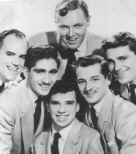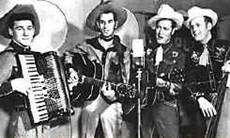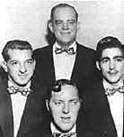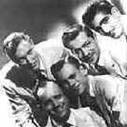Some More about Western Swing - Bill Haley
By
Leocthasme
New Page 1
In
Past Issues of Pencilstubs I have written articles
about Western Swing and on
some of the bands that made the genre popular. So
here is a bit more information
on the subject.
Bill Haley and His Comets

What? You
didn’t know Bill Haley and His Comets was once a
bunch of country and Western
Swingers. Well
here is the
story as I found it.
Bill Haley
and The Comets
fused elements of country music, Western swing,
and black R&B to produce
some of rock and roll's earliest hits. His
"Crazy, Man Crazy" from
1953 was the first rock and roll record to
make the pop charts.
Bill Haley
was born in
Highland Park
,
Michigan
on July 6, 1925 to William and Maude Haley, the
couple's second child.
The family
had moved to
Detroit
from Firebrick,
Kentucky
where William Sr. found work in a nearby service
station as a mechanic while
his wife gave piano lessons in their home for
twenty five cents an hour. Later
the family moved to Boothwyn near the town of
Chester,
Pennsylvania
.
Haley's
father played the
banjo and mandolin. Though he couldn't read music
he had an ear for country
music and was able to pick out any tune he wanted
by ear. At thirteen Haley
received his first guitar. His father taught him
to play the basic chords and
notes by ear. It was at this time he began his
dream of becoming a singing
cowboy like the ones he idolized every Saturday
afternoon at the movie houses in
nearby Marcus Hook or
Chester
.
In June of
1940, just
before his fifteenth birthday, Haley left school
after finishing the eighth
grade and went to work bottling water at Bethel
Springs. This company sold pure
spring water and fruit flavored soft drinks in a
three state area. Here he
worked for 35 cents an hour, filling large five
gallon glass bottles with spring
water.
At 18 he made
his first
record "Candy Kisses" and for the next
four years was a guitarist and
singer with country and western bands. After
time on the road with the ‘Down Homers’, Haley
returned to his parents' home
in Booth's Corner in September of 1946. He
was ill, disillusioned and so broke he had to walk
from the train station in
Marcus Hook four miles to Booth's Corner. His only
request to his mother was not
to tell anyone he was home, not even his fiancée
Dorothy. Bill fell into bed
and slept thirty hours. Over the
next two weeks Mrs. Haley slowly nursed her
itinerant son back to health.
By the age of
21, Haley
felt he wasn't going to make it big as a cowboy
singer and ill left the 'Down
Homers', and returned to
Chester
to host a local radio program. At
this time he also married his childhood sweetheart
Dorothy Crowe a beautiful
part American Indian girl.
Haley was hired in 1947 as musical director for
radio station WPWA. Working
twelve to sixteen hours a day, six days a week he
interviewed dozens of local
people, always looking for good ideas and new
talent. Each Sunday he would go to
Radio
Park
and invite celebrities to do a special half hour
program where he would
interview them and ask them to sing or play their
latest tunes.

The Four Aces of Swing
( l to r Al Constantine, Tex King, Bill Haley, and
Bashful Barney)
It was during
this time
that he put together a band ‘The Four Aces Of
Swing’ that performed on his
show. In 1948 on the Cowboy label Haley recorded
with The Four Aces of Western
Swing’. The Four Aces disbanded in mid '49 and
Haley formed a new band the
‘Down Homers’ and he recorded country music. Later
he left the group to return to
Chester
to host a local radio program.
In the summer
of 1950,
through the efforts of Jimmy Myers, Bill Haley and
his ‘Saddlemen’ cut their
first records. They were on Ed Wilson's Keystone
label, a small
Philadelphia
independent publisher. The songs were standard
western swing tunes: "Deal
Me A Hand", "Ten Gallon
Stetson",
"Susan Van Dusan", and "I'm
Not To Blame", They
were the first recordings of the band that would
become the nucleus of the world
famous Comets.
With their
new, exciting
sound the name "Saddlemen" no
longer seemed appropriate.
According to Marshall Lytle, it was Bob Johnson,
Program Director at WPWA who
first suggested the name Haley's Comets.
"Ya'
know, with a name like Haley, you guys
should call your group the
Comets!"
Just before the Thanksgiving holidays in 1952,
Haley's band changed their name
and their image for the last time. Off came the
cowboy boots and the white
Stetsons. With some regrets and more than a little
apprehension, the four young
musicians, turned their backs on their beloved
country western music and bravely
faced an unknown future as "Bill Haley and
His Comets".
One example
of that change
was "Rock the Joint" which sold 75,000
copies. In 1953 he wrote
"Crazy Man Crazy" which became the first
rock and roll record to make
the Billboard pop chart reaching the Top
20.
|

Comets in 1952
|

Comets in 1953
|
On April 1st,
1954, Myers,
Gabler and Bill Haley met in Decca's
New York
offices. The three men discussed a contract for
four records a year, a standard
royalty of 5% of sales, $5,000.00 in advance
royalties, and the understanding
that Decca would mail out each release to two
thousand disc-jockeys with full
support publicity. Plus full page ads in Billboard
and Cash Box magazines! With
the deal set and signed, the three men shook hands
and agreed on a recording
date four days after the Essex contract was due to
expire.
It was while
at Decca that
Haley fell under the influence of Milt Gabler
who had produced Louis Jordan. Gabler would
convince Haley to change his sound.
That change would be evident when on April 12th
1954, at Pythian Temple Studio
with the recording of "Rock Around the
Clock." The song that
introduced rock & roll to White America.
"Rock Around the Clock"
originally recorded by Sunny Dae in 1952,
"Rock Around the Clock" had
initial sales topping 75,000. "Rock Around
the Clock" was a modest
hit, until the song was used as the title track of
"The Blackboard
Jungle", a movie about juvenile delinquents,
some 12 months later.
His next
record a cover of
Joe Turner's ‘Shake, Rattle and Roll' was a top
ten hit. It was the
first rock & roll record to sell a million
copies
The next really big hit came with "See
You Later Alligator"
which sold a million copies within a month.
In 1957,
Haley began
touring
Britain
as his popularity began fading at home. The
first American Rock and Roll
star to come to
Britain
, he was met with large and enthusiastic crowds.
The British soon found out what
American teenagers already knew. Haley with his
spit curl was old (30),
overweight and rather mechanical when compared to
Little Richard, Jerry Lee
Lewis, Gene Vincent and Elvis who were younger and
whose music was more
exciting. Bill Haley & His Comets were there
first, but now they were part
of the establishment.
After 1957
Haley had a few
minor hits, but spent the remainder of his life
touring and playing Rock and
Roll Revival shows. In the early morning hours of
February 9th, 1981, Bill
called two of his sons, Scott and Jack, and had
his last known conversations. He
died, in his sleep of an apparent heart attack,
about 6:30 that morning at his
home in
Harlingen
,
Texas
.
Bill Haley
was inducted
into The Rock and Roll Hall of Fame in 1987.
Click on author's byline for bio and list of other works published by Pencil Stubs Online.
| 




